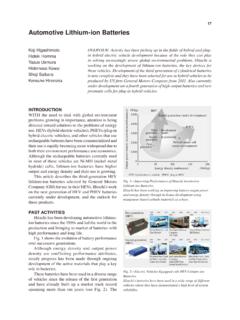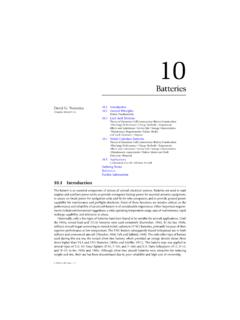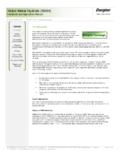Transcription of Single-cellBattery Discharge Characteristics Using …
1 Application Report SLVA194 AUGUST 2004. single -cell Battery Discharge Characteristics Using the TPS61070 Boost Converter SK Loo and Keith Keller .. Power Management Products ABSTRACT. This application report presents practical single -cell battery Discharge Characteristics in real-world application, and primarily focuses on the varying internal impedance of a battery and how that affects the battery terminal voltage. Contents 1 Introduction .. 2. 2 Battery Chemistry and Circuit Model .. 2. 3 Battery Terminal Voltage vs Internal Cell 3. 4 Internal Resistance of a Battery vs Battery Energy State .. 5. 5 Alkaline Battery Testing .. 5. 6 NiMH Battery Testing.
2 7. 7 Device Start-up vs Temperature .. 9. 8 Summary .. 10. List of Figures 1 Battery Structure, Basic Circuit Model, and Discharge Characteristics .. 3. 2 Discharge Curve of single -Cell Battery Under Different Load Conditions .. 3. 3 A Typical AA-Size Alkaline Battery Voltage at No Load Versus at 330-mW Discharge .. 4. 4 Open Load and 85-mW Step Load of Alkaline Battery with Terminal Voltage of V (Left) and V (Right) .. 6. 5 Open Load and 85-mW Step Load of Alkaline Battery with Terminal Voltage of V (Left) and V (Right) .. 6. 6 Pulse Load of 10-sec Duration Showing the Battery Open Load Voltage (Left) and Loaded Voltage Until Device Shutdown (Right).
3 6. 7 Open and Step Load of NiMH Battery at Almost-Full Energy Capacity of 800 mAH (Left) Open and Step Load of NiMH Battery at 1/2-Full Energy Capacity of 800 mAH (Right) .. 7. 8 Open and Step Load of NiMH Battery at 1/4-Full Energy Capacity of 800 mAH (Left) Open and Step Load of NiMH Battery at 1/10-Full Energy Capacity of 800 mAH (Right) .. 8. 9 Pulse Load of 10-sec Duration Showing the Battery Open-Load Voltage (Left) and Loaded Voltage Until Device Shutdown (Right) .. 8. 10 Pulse Load of 10-sec Duration Showing the AAA-Size NiMH Battery Open Load Voltage (Left) and Loaded Voltage Until Device Shutdown (Right) 550 mAH Capacity .. 9. SLVA194 AUGUST 2004 single -cell Battery Discharge Characteristics Using the TPS61070 Boost Converter 1.
4 Introduction 11 TPS61070 Start-up Voltage vs RL at Different Temperatures .. 9. List of Tables 1 TPS61070 Data Sheet Excerpt Showing Start-up Voltage .. 2. 2 Specifications for an Alkaline and NiMH Battery.. 5. 1 Introduction Regardless of battery chemistry alkaline, nickel cadmium (NiCd), or nickel metal hydride (NiMH) in single -cell applications the battery voltage can be drained as low as V ~ V when the battery is finally empty. Ideally, the dc/dc boost converter start-up/operating voltage range should be specified down to this voltage range. This is true of Texas Instruments' TPS6101x family of devices; the start-up voltage is specified as V to alleviate potential issues regarding start-up in such a low-voltage condition.
5 After the device is started, it can be operated down to V. Texas Instruments' TPS61070/1 devices have a typical start-up voltage specified as V (with a worst case start-up voltage of V). However, once started, these devices can operate at < V. The typical specified battery voltage in data specifications for NiMH batteries is V. The typical Discharge curve of both nickel and alkaline batteries is a non-linear curve from V down to V (with some battery capacity remaining when the battery voltage is below V). These battery voltage specifications, and the start-up specifications of the TPS61070/1, generated some questions as to whether it is suitable for single -cell battery applications.
6 In both cases, device start-up and battery energy utilization, the TPS61070. works well in single -cell applications. Table 1. TPS61070 Data Sheet Excerpt Showing Start-up Voltage DC/DC STAGE. PARAMETER TEST CONDITIONS MIN TYP MAX UNIT. VI Minimum input voltage range for start-up RL = 270 V. Input voltage range, after start-up VO TPS61070 output voltage range V. 2 Battery Chemistry and Circuit Model To address the differences between start-up voltage and operating voltage, it is necessary to understand the basic structure of the battery. A simple model is represented in Figure 1. When the battery is not loaded, the terminal voltage is equal to the internal cell voltage, because there is no current flowing through the battery's internal series resistor.
7 This is indicated by the solid blue line of Figure 1 and shows the actual cell voltage and the terminal voltage at no load. 2 single -cell Battery Discharge Characteristics Using the TPS61070 Boost Converter SLVA194 AUGUST 2004. Battery Terminal Voltage vs Internal Cell Voltage Cathode Electrolyte Anode Constant Current Disgharge, Transient Effect ON. OFF. Voltage V. I .R. 0 500 1000 1500 2000 2500 3000 3500 4000 4500. Capacitor Rc Cc Ra Ca Capacitor + Resistor Bat Rser Bat + Battery Cc2 Ca2. Figure 1. Battery Structure, Basic Circuit Model, and Discharge Characteristics Once a load is applied to the battery, current flowing through the cells induces a voltage drop (I R).
8 Across the internal series resistor (or sometimes referred to as the internal impedance of the battery), resulting in a lower terminal voltage versus the cell voltage. In steady-state conditions this I R voltage is directly proportional to the load current multiplied with the internal resistance, as shown in Figure 2. However, during transient load conditions, due to the internal equivalent capacitance between the electrode, electrolyte, and separator, the actual terminal voltage is non-linear and does not represent a direct relationship with the I R drop. At the initial condition of the load, due to this internal battery capacitance, the terminal voltage drops slightly slower due to the Discharge of the equivalent capacitance voltage.
9 After removal of the load, the terminal voltage does not recover to the cell voltage immediately. Rather, it takes several tens to hundreds of seconds for the terminal voltage to recover back to the cell voltage as shown in Figure 1. Voltage V. Actual capacity I*R. Usable capacity Capacity, Ah Quse Qmax Figure 2. Discharge Curve of single -Cell Battery Under Different Load Conditions 3 Battery Terminal Voltage vs Internal Cell Voltage A commonly misunderstood concept of battery voltage is that the specified Discharge voltage curve in the data sheet indicates the voltage under a specified load condition. The data sheet fails to mention the cell voltage internal to the battery, hence, misleading the engineer into thinking that the terminal voltage at no load is the same as the terminal voltage under a load condition.
10 This case only exists if the load on the SLVA194 AUGUST 2004 single -cell Battery Discharge Characteristics Using the TPS61070 Boost Converter 3. Battery Terminal Voltage vs Internal Cell Voltage battery is so small that it does not generate noticeable voltage drop across the battery's internal resistance. This leads to discussion on whether the TPS61070/1 may not start up Using an almost-depleted battery, and subsequently, not fully use the battery's capacity. The following experiment shows that in an actual application of a few tens of milliWatts, almost all energy in the battery is used and the device readily starts up. Figure 3 shows the test results of a AA-size alkaline battery under a constant power Discharge of 330 mW.


















